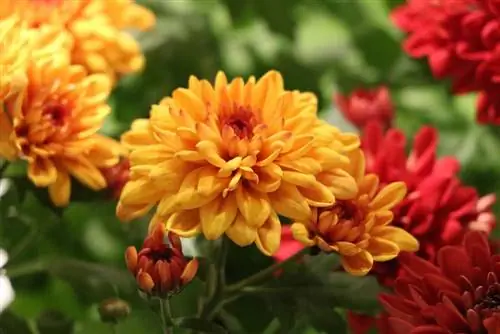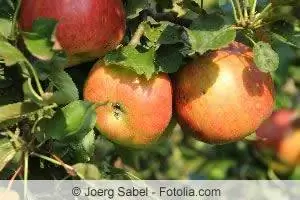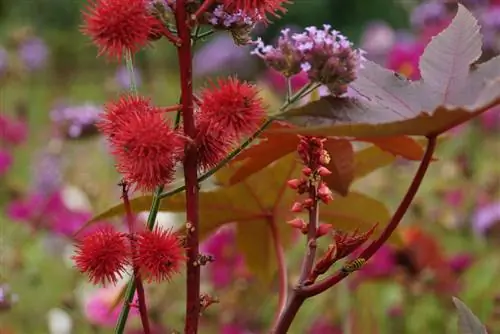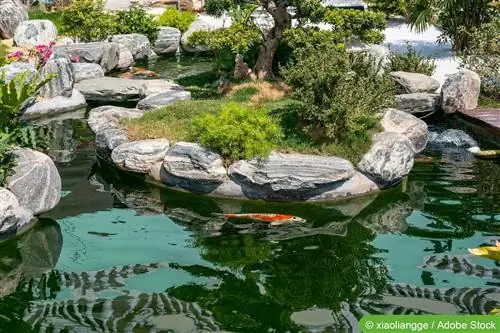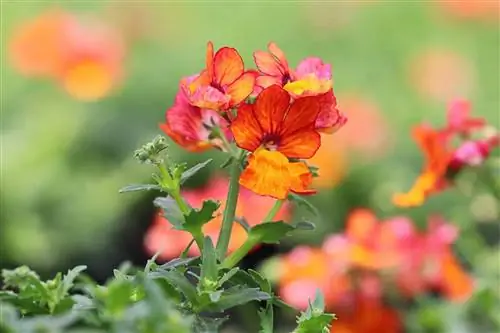- Author admin [email protected].
- Public 2023-12-17 03:39.
- Last modified 2025-01-24 12:45.
The boar rue plant is a herbal plant that is also becoming increasingly popular in the kitchen. As a relative of mugwort, tarragon or wormwood, it exudes a scent of lemon, camphor or even cola, depending on the culture type. This meant that it was already very popular as a room fragrance in ancient times. Originally native to America, Asia and southern Europe, it is also finding more and more fans in these latitudes, especially because the perennial Artemisia abrotanum can also find a place on a windowsill.
Location
Since the boar rue plant originally comes from warm places such as the Mediterranean countries, it needs a full sun location to thrive. This can be cultivated directly in the garden bed or in a pot on a terrace, a south-facing balcony or on a south-facing window on the windowsill. Artemisia abrotanum is also often planted as a ground cover in the garden bed or on a slight slope. It is also very suitable as a small hedge, for example as a boundary to a vegetable patch.
Tip:
The intensive smell it exudes means it repels pests and this can also benefit the plants in the kitchen garden.
Substrate & Soil
In the best case scenario, the soil for the boar rue plant is slightly calcareous and permeable. Therefore, mix some sand, stones or gravel into the soil when planting to ensure permeability. Otherwise, the following should be taken into account when choosing the floor:
- Avoid waterlogging at all costs
- Mix in zeolite or pumice
- Continuous wetness can damage the plant, especially in winter
Watering & Fertilizing
The boar rue plant doesn't need much. Always give water only moderately; for Artemisia abrotanum planted outdoors, falling rain is completely sufficient. Watering only needs to be done for plants grown in pots and during long periods of drought in the summer. But even in these cases, it is better to water too little than too much, because the boar rue plant can tolerate longer periods of dryness rather than too much moisture. You don't need to fertilize much either:
- Use compost or horn shavings for fertilization in spring
- mix these into the ground
- Improve a low-lime soil with garden lime from the market
Cutting
The plants should be cut back to the woody main shoot in spring because they have a great need for growth. They then sprout again vigorously. If the boar rue plants have become too strong and dense as a ground cover or hedge for you, you can cut the Artemisia abrotanum back close to the ground in autumn so that a new shape emerges later in spring.
Propagate
Eberrue can be propagated in three different ways, cuttings, sowing or root division. Since seeds are usually not formed on plants cultivated in the garden in the local climate, they have to be purchased commercially. Propagation is easy in all three variants:
- The ideal time for cuttings is spring
- cut new long shoot with tip
- Keep the soil in the pot moist and put the bag over it
- It takes a little patience for root formation
- Use commercial seeds for sowing
- these are light germinators, so don't stick them deep into the ground but just sprinkle them on top
- due to pests such as ants that attract seeds in pots
- Prick out when small leaves form
- plant in the location when small, strong boar rue plants have formed
- The entire plant must be removed from the ground for root division
- remove soil from the roots altogether
- use a sharp knife to divide the roots and thus also the Artemisia abrotanum in the middle
- Replant with enough distance between each other and other plants
Tip:
Since propagation with cuttings is usually only successful in half of all cases, seeds or the simple method of division should be used.
Plants
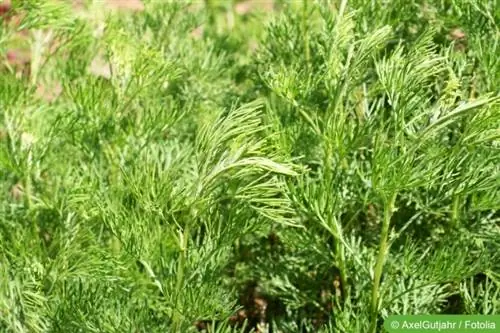
When planting boar's rue, it is important to ensure that several plants are not planted too close together. A distance of around 30 cm all around is ideal here. The Eberrue plant likes to spread and therefore needs enough space on all sides. When planting in the garden bed, proceed as follows:
- Choose a sunny location and make sure there is enough space on all sides
- Dig hole
- mix excavated soil with compost and horn shavings
- Insert the plant and add soil again, press lightly
- Water enough, avoid adding water at all in the next few weeks
Cultivation in a bucket
If the boar's rue is cultivated in a pot, you should proceed as follows:
- Create drainage over the drain hole
- to do this, pile up gravel, stones or pottery shards and place plant fleece over them
- Use garden or pot soil
- if necessary, enrich with garden lime
- Insert the plant and fill the soil all around and press it lightly
- water lightly, do not flood
- After a while, pour excess water out of the saucer
- repotting is actually not necessary
- If you like, you can change the soil every two to three years
- If you always use hard water, you can save yourself having to replace the soil
- you don't have to choose a larger pot here
Wintering
The boar rue plant is hardy and therefore does not need extra protection. It is usually enough if it is cut to the ground in autumn. Then put brushwood around on the ground and the remaining plants. This protects the Artemisia abrotanum from too much moisture in winter, which it doesn't do well in combination with cold.
Care errors, diseases or pests
Due to the exudation of essential oils, the boar's rue has few pests that could harm it. On the contrary, when planted between or around a kitchen garden, its smell drives away annoying flies and parasites that could be harmful to the vegetables being grown. However, even aphids can affect it. These attach themselves to the shoots and leaves of Artemisia abrotanum. If the shoot tips of the plant are deformed and the leaves are curled and yellowed, action must be taken. A water/curd soap solution that the hobby gardener simply sprays onto the plants has proven successful here.
Tip:
If you cultivate your boar rue plant in a pot and place it at the corners of the terrace, you will have fewer flies on the table in summer.
Boar's rue as tea
As mentioned at the beginning, you can make tea from the leaves of the boar's rue. The fresh shoots are harvested from June until flowering. The leaves can be made into tea fresh or dried. To make the tea, a branch is brewed with half a liter of water and then steeped for ten minutes. If it is dried boar's rue leaves, a tablespoon of crushed herb is scalded with half a liter of water and then left to steep for five minutes.
The tea serves as a tonic and is also used in natural medicine to treat gastrointestinal complaints and digestive problems. It is also said that boar's rue can wonderfully strengthen the immune system and is also a perfect cold remedy. The tea is also said to give new strength, which particularly benefits sick and older people. For use in the kitchen, the fresh leaves of the boar's rue are cut off and can then be dried. You can also freeze the fresh leaves.
Conclusion
The boar's rue is a herbal plant for everyone who likes to keep things simple. Since it is very easy to care for, does not require a lot of water or fertilizer and places few demands on the location, it is a wonderful fragrant plant even for beginners. Cultivated in a pot on the terrace, it also has a pleasant aroma that ensures that flies stay away. It can also be used as a tea or as a spice in the kitchen.
Special features
- The boar's rue is also known as lemon herb and has the botanical name “Artemisia abrotanum”.
- This plant is also called the Cola bush because when you lightly stroke the fine leaves, it gives off a scent that is reminiscent of the taste of Cola.
- Eberraute originally comes from southern Europe. Today they are found not only in Central and Southern Europe, but also in North America and the Near East.
- The perennial, perennial plant is used as a crop. Their aromatic leaves are used, for example, in flower water, mothballs and potpourris.
- You can also make a tea from the leaves, which is used as a tonic.
- The boar's rue is also used as a bath additive or poultice. This allows major problems to be addressed.
- In the kitchen, boar's rue is used as a culinary herb for salads, sauces, fish and quark dishes.
Tip:
Due to the very intense smell, boar's rue should only be used very sparingly.
- In addition to these uses, the boar's rue is also perfect as a bed border.
- The boar's rue herb is also a perfect mosquito repellent, because if you rub the herb on yourself, mosquitoes stay away.
- The boar's rue grows between 70 and 100 cm tall and is an upright, bushy growing plant.
- The period from July to September is the typical flowering time, in which the plants show inconspicuous to yellowish flowers.
Care and cut
- The boar's rue thrives best in a sunny location and prefers a well-drained, moderately dry to fresh soil.
- This should be slightly alkaline to alkaline. The boar's rue does not tolerate waterlogging and must be protected from waterlogging, especially in the cooler season.
- The individual plants are planted at a distance of 40 to 50 cm from each other.
- The perennial plant can easily remain in the same place for three to four years.
- Otherwise the boar's rue is a very undemanding plant because you usually don't need to water it additionally as normal rain is sufficient.
- In hot summers, with long dry periods, however, you have to help a little with irrigation.
- You can propagate boar's rue from cuttings, although there are numerous nurseries that offer this plant in spring.
- The boar's rue is a perennial plant that is hardy. This means she can overwinter without any problems.
Cutting
The shoots are only shortened in spring, which can be done without any problems down to the woody main shoot. This allows the plant to sprout again quickly and strongly. If you make a cut to beautify the growth habit, you can also use the boar's rue to create a tall herb hedge that can even function as a privacy screen.


